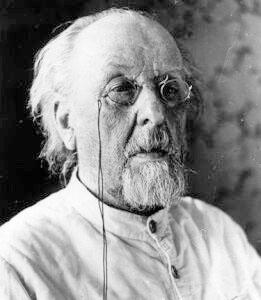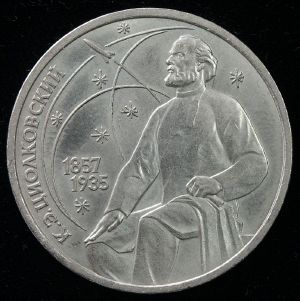Konstantin Tsiolkovsky
Konstantin Eduardovich Tsiolkovsky (Константин Эдуардович Циолковский, Konstanty Ciołkowski) (September 5, 1857 (new style) – September 19, 1935) was a Russian and Soviet rocket scientist and pioneer of cosmonautics who spent most of his life in a log house on the outskirts of the Russian town of Kaluga.
He was born in Izhevskoye (now in Spassky District), Ryazan Oblast, Russia, in a middle-class family with 18 children. His father, Edward Ciołkowski, was Polish; his mother, Maria Yumasheva, was Russian and an educated woman. As a 10 years old child, Konstantin caught scarlet fever and became hard of hearing. For this reason he was not accepted at elementary schools, so he was home schooled instead. He had never received any formal education. His father's library became his school, his disability became his driving force.
While living in Moscow in 1873-1876 he continued his self-education and spent most of his time in libraries. Besides, he was fortunate to get a philosopher Nikolai Fedorovitch Fedorov as his personal tutor. Leading proponent of Russian Cosmism, he became a one man university for Konstantin. Fedorov's lectures and, in part, Jules Verne's novels became a source of inspiration of the space flight. Since that time he began to think about the problems of space vehicle design. The idea was not only to go into outer space, but to conquest space, so humainity can become a space civilization.
Nearly deaf, he worked as a high school mathematics teacher until retiring in 1920. Tsiolkovsky theorized many aspects of space travel and rocket propulsion. He is considered the father of human space flight and the first man to conceive the space elevator, after visiting Paris in 1895 and becoming inspired by the newly-constructed Eiffel Tower. His most famous work was Исследование мировых пространств реактивными приборами (The Exploration of Cosmic Space by Means of Reaction Devices), published in 1903, which was arguably the first academic treatise on rocketry. Tsiolkovsky calculated that the speed required to orbit the Earth is 8 km/second and that this could be achieved by means of a multi-stage rocket fueled by liquid oxygen and liquid hydrogen. During his lifetime he published over 500 works on space travel and related subjects, including science fiction novels. Among his works are designs for rockets with steering thrusters, multi-stage boosters, space stations, airlocks for exiting a spaceship into the vacuum of space, and closed cycle biological systems to provide food and oxygen for space colonies. Unfortunately his ideas were for many years little known outside Russia, and the field lagged until German and other scientists independently made the same calculations decades later.
His work influenced later rocketeers throughout Europe, and was also studied by the Americans in the 1950s and 1960s as they sought to understand the Soviet Union's early successes in space flight.
Tsiolkovsky also delved into theories of heavier-than-air flying machines, independently working through many of the same calculations that the Wright brothers were doing at the same time. However, he never built any practical models, and his interest shifted to more ambitious topics.
Friedrich Zander became enthusiastic about Tsiolkovsky's work and active in promoting and developing it. In 1924 he established the first Cosmonautics Society in the Soviet Union, and later researched and built liquid-fuelled rockets named OR-1 (1930) and OR-2 (1933). On August 23, 1924 Tsiolkovsky was elected as a first professor of the Military-Air Academy N. E. Zhukovsky.
In 1929 Tsiolkovsky proposed the construction of staged rockets in his book Космические поезда (Cosmic Trains).
The basic equation for rocket propulsion, the Tsiolkovsky rocket equation, is named after him.
He was also an adherent of philosopher Nikolai Fyodorov, and believed that colonizing space would lead to the perfection of the human race, with immortality and a carefree existence.
Tsiolkovsky died on September 19, 1935 in Kaluga, Russia and was buried in state. A museum of astronautics in Kaluga now bears his name, as do Tsiolkovskiy crater on the far side of the moon and asteroid 1590 Tsiolkovskaja.
Quote
"The Earth is the cradle of humanity, but one can not live in a cradle forever!"
"Men are weak now, and yet they transform the Earth’s surface. In millions of years their might will increase to the extent that they will change the surface of the Earth, its oceans, the atmosphere and themselves. They will control the climate and the solar system just as they control the Earth. They will travel beyond the limits of our planetary system; they will reach other Suns and use their fresh energy instead of the energy of their dying luminary."
Tribute
A fictional ship, the К. Э. Циолковский (K. E. Tsiolkovsky), was named after him for the television series Star Trek: The Next Generation. The episode it appeared in was entitled "The Naked Now". A copy of the dedication plaque of that vessel, with a rough rendering of Tsiolkovsky's Cyrillic name, was seen in the ship's set dressing. (the artist mistakenly used "З" instead of "Э" for the middle initial, and "п" instead of "л" in the last name).
- К. Э. Циолковский at Memory Alpha
External links
- The life of Konstantin Eduardovitch Tsiolkovsky An excellent article with refererences, facsimile articles and more
- Tsiolkovsky's Imperative in the 21st Century Acedemic paper
- Virtual Matchbox Labels Museum - Russian labels - Space - Page 2 - Konstantin Tsiolkovsky Historic images
- Tsiolkovsky from Russianspaceweb.com
- Spaceflight or Extinction: Konstantin Tsiolkovsky Excerpts from "The Aims of Astronautics", The Call of the Cosmos
- The Foundations of the Space Age
- The SS Tsiolkovsky at Memory Alpha - the Star Trek wiki
Credits
New World Encyclopedia writers and editors rewrote and completed the Wikipedia article in accordance with New World Encyclopedia standards. This article abides by terms of the Creative Commons CC-by-sa 3.0 License (CC-by-sa), which may be used and disseminated with proper attribution. Credit is due under the terms of this license that can reference both the New World Encyclopedia contributors and the selfless volunteer contributors of the Wikimedia Foundation. To cite this article click here for a list of acceptable citing formats.The history of earlier contributions by wikipedians is accessible to researchers here:
The history of this article since it was imported to New World Encyclopedia:
Note: Some restrictions may apply to use of individual images which are separately licensed.


